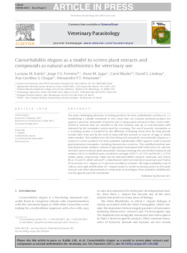Caenorhabditis elegans as a model to screen plant extracts and compounds as natural anthelmintics for veterinary use.
Caenorhabditis elegans as a model to screen plant extracts and compounds as natural anthelmintics for veterinary use.
Author(s): KATIKI, L. M.; FERREIRA, J. F. S.; ZAJAC, A. M.; MASLER, C.; LINDSAY, D. S.; CHAGAS, A. C. de S.; AMARANTE, A. F. T.
Summary: The most challenging obstacles to testing products for their anthelmintic activity are: (1) establishing a suitable nematode in vitro assay that can evaluate potential product use against a parasitic nematode of interest and (2) preparation of extracts that can be redissolved in solvents that are miscible in the test medium and are at concentrations well tolerated by the nematode system used for screening. The use of parasitic nematodes as a screening system is hindered by the difficulty of keeping them alive for long periods outside their host and by the need to keep infected animals as sources of eggs or adults when needed. This method uses the free-living soil nematode Caenorhabditis elegans as a system to screen products for their potential anthelmintic effect against small ruminant gastrointestinal nematodes, including Haemonchus contortus. This modified method uses only liquid axenic medium, instead of agar plates inoculated with Escherichia coli, and two selective sieves to obtain adult nematodes. During screening, the use of either balanced salt solution (M-9) or distilled water resulted in averages of 99.7 (±0.73)% and 96.36 (±2.37)% motile adults, respectively. Adult worms tolerated DMSO, ethanol, methanol, and Tween 80 at 1% and 2%, while Labrasol® (a bioenhancer with low toxicity to mammals) and Tween 20 were toxic to C. elegans at 1% and were avoided as solvents. The high availability, ease of culture, and rapid proliferation of C. elegans make it a useful screening system to test plant extracts and other phytochemical compounds to investigate their potential anthelmintic activity against parasitic nematodes.
Publication year: 2011
Types of publication: Journal article
Observation
Some of Embrapa's publications are published as ePub files. To read them, use or download one of the following free software options to your computer or mobile device. Android: Google Play Books; IOS: iBooks; Windows and Linux: Calibre.
Access other publications
Access the Agricultural Research Database (BDPA) to consult Embrapa's full library collection and records.
Visit Embrapa Bookstore to purchase books and other publications sold by Embrapa.

